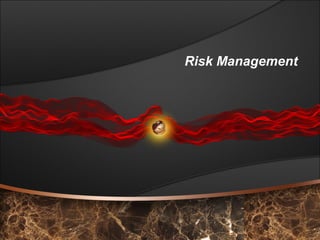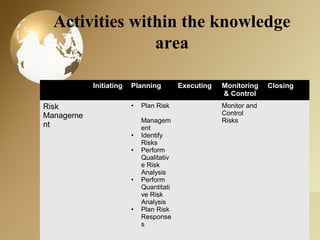Risk Management for A Project
- 2. Art and science of identifying, assigning, and responding to risk throughout the life of a project and in the best interests of meeting project objectives Protects the scope of the project(time,cost and quality)
- 3. Activities within the knowledge area Initiating Planning Executing Monitoring Closing & Control Risk • Plan Risk Monitor and Manageme Control Managem Risks nt ent • Identify Risks • Perform Qualitativ e Risk Analysis • Perform Quantitati ve Risk Analysis • Plan Risk Response s
- 4. ????? The project team should review project documents and understand the organization’s and the sponsor’s approaches to risk •Project Manager •Project Team •Risk Manager •Client/Business Line Owner •Stakeholders
- 5. most important to be carried out in this knowledge area Monitor and control risk as you execute your project. •- What are the specific types of risks •How are we going to mitigate •What are the mitigation strategies •Who all the people responsible •How much resource need
- 6. Challenges • Inadequate Planning – Working on revising the entire plan • Poor Definition of Scope – Holding meeting with the project customer and sponsor to clarify scope • Poor Cost estimates – Revising cost estimates • Poor time estimates – Revising schedule estimates






